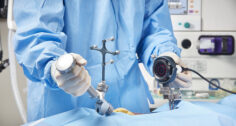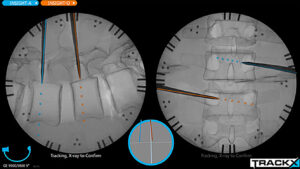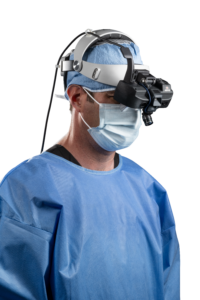
Vinay Aggarwal, M.D., has zero doubt that surgical robots and navigation platforms will play important roles in the continuous evolution of joint replacement surgery and recognizes their clinical value. But are they necessary?
“The reported benefits of these enabling technologies include increased precision, particularly in terms of implant placement and reproducibility,” said Dr. Aggarwal, Assistant Professor of Orthopedic Surgery at NYU Grossman School of Medicine. “However, it’s essential to critically evaluate whether they reduce complications and improve outcomes.”
Dr. Aggarwal also pointed to several potential disadvantages associated with robotic surgery and conventional navigation, including substantial capital expense, space constraints in the O.R. and a learning curve for surgeons. Then there’s the implant issue. Many surgeons prefer to use specific implants, in most cases restricting themselves to a particular robotic platform.
Enter handheld navigation tools, which offer a cost-effective and efficient alternative to standard navigation and surgical robots. Dr. Aggarwal said the devices don’t alter familiar surgical workflows during hip replacement surgery. After draping the patient, the surgeon registers anatomical landmarks like they would with conventional robotic systems. The registration determines the location of the hip’s center and the mechanical axis of the femur to ensure precise alignment of the joint.
During the procedure, adjustments can be made with millimeter precision for flexion, varus, valgus and depth of resection in sagittal and coronal planes, according to Dr. Aggarwal. “When surgeons are satisfied with the parameters, they begin making the bone cuts,” he said.
Dr. Aggarwal noted that handheld navigation tools are particularly useful during revision surgeries. He discussed the case of a patient presenting with a dislocated cup. Instead of relying solely on a static CT scan, which provides a fixed view of the patient’s condition, handheld navigation offers a dynamic intraoperative reference plane.
“The plane allows surgeons to make precise adjustments based on the patient’s current hip composition, addressing issues such as under rotation or over inversion,” Dr. Aggarwal said. “By measuring and adjusting parameters such as limb length and offset, revision surgery becomes significantly more manageable. These adjustments lead to improved patient outcomes, even during challenging cases.”
Handheld navigation also provides significant benefits when surgeons place articulating spacers during the removal of infected implants. Dr. Aggarwal said the technology helps surgeons refine the positioning of implants, even in complex scenarios like hip impingement, so they achieve accurate outcomes that are on par with robotic technology.
“Robots aren’t the sole solution in surgical navigation,” Dr. Aggarwal said. “It’s crucial to consider where robotic assistance truly adds value compared to what can be achieved with handheld devices.”
For instance, he said, handheld navigation devices have demonstrated effectiveness in modifying acetabular cup positions or creating articulate spacers without the need for additional surgery.
Dr. Aggarwal noted that the benefits of handheld navigation extend to various orthopedic procedures. Plus, with open platform systems, surgeons can choose implants that best suit their patients’ needs.
“The era of relying solely on visual estimation in surgery is fading,” he said. “Handheld navigation offers intraoperative precision and reliability to enhance surgical outcomes and patient satisfaction. It’s an area of joint replacement surgery that is worth exploring.”

TrackX provides virtual live fluoroscopy and re-calibrates instrument locations in real time.
Pinpoint Control
TrackX instrument tracking technology combines live pseudo fluoroscopy with virtual navigation, allowing surgeons to visualize their movements in real time without radiation exposure. This innovative platform aims to enhance surgical precision and efficiency while significantly reducing radiation risks during the 17 billion fluoroscopic procedures performed annually in the U.S., according to Robert Isaacs, M.D., CEO and Founder of TrackX.
The tracking technology is FDA-cleared for use across the body. Dr. Issacs is initially focused on selling the platform to high-volume spine surgeons but plans to expand into the trauma and foot and ankle markets.
Unlike traditional fluoroscopy and robotic navigation systems, which can be cumbersome and expensive, Track X seamlessly integrates into existing surgical workflows. By attaching sensors to conventional surgical instruments, surgeons can use familiar tools while benefiting from real-time navigation guidance. This integration results in greater accuracy, substantial time savings and over 90% reduction in radiation exposure compared to standard fluoroscopy, according to Dr. Isaacs.
He said TrackX’s compact design, user-friendliness and affordability make the platform appealing to outpatient facilities that face challenges with adopting new technologies due to cost and complexity. “Unlike other systems that require additional infrastructure and significant capital investments, our system can be added without the need for expensive upgrades,” Dr. Isaacs said. “We employ a razor-and-blade strategy, providing the unit for free and generating revenue from disposables.”
The company has made significant strides in lateral interbody fusion procedures, which Dr. Isaacs said typically don’t involve intraoperative imaging or enabling technology. “We’re changing that,” he added. “TrackX can be used during every aspect of the procedure, resulting in faster, more precise surgeries with minimal radiation exposure.”

The ARVIS augmented reality headset from Enovis is a hands-free guidance technology that’s engineered for orthopedic surgeons.
Heads-up Displays
Conventional navigation and robotics systems rely on foundational technologies such as infrared and 3D localizer cameras, as well as traditional computer equipment. Advancements made by companies like Apple, Meta and Microsoft in visualization technology and spatial computing capabilities allowed Enovis to convert conventional surgical navigation technology into an augmented reality (AR) device specifically designed for orthopedic surgeons to use during hip and knee replacements, said Marc Mackey, the company’s General Manager and Senior Vice President of Enabling Technologies.
The ARVIS headset weighs only eight ounces and features depth-sensing cameras, allowing surgeons to visualize the surgical field and display overlays of surgical information directly onto the patient’s anatomy while eliminating the need to glance at secondary monitors in the surgical field.
“We’re still in the early stages of AR adoption in surgery,” Mackey said. “With access to cutting-edge technologies like machine learning and convolutional neural networks for processing video information, we’re on the brink of exciting advancements in the field.”
Creating preoperative plans and referencing the images during surgery allows surgeons to assess the knee’s soft tissue envelope and optimize the balance of the joint’s ligaments, which isn’t feasible when solely manipulating implants based on bony position. “This is a significant advantage,” Mackey said.
ARVIS’ functionality is similar to traditional navigation platforms. After surgeons register the patient’s anatomical landmarks in the knee, the device provides visual cues and key information at each surgical step. For instance, during the distal cut, surgeons can see overlays of the alignment of the cut in terms of rotational varus, valgus, flexion and extension, in addition to distal resection levels and linear measurements relative to the anatomy.
“Studies indicate that AR can enhance the surgeon’s sense of proprioception, aligning hand-eye coordination more accurately with the intended manipulation of objects within the surgical field,” Mackey said. “By displaying pertinent information directly within the surgeon’s line of sight, AR facilitates manipulation tasks while allowing surgeons to maintain their focus on the surgical field.”
Another important consideration for surgeons is cognitive load, which refers to the amount of information presented during surgery. AR can help reduce cognitive load by minimizing distractions and displaying only relevant information for the current task. Mackey said numerous studies have explored the impact of AR on cognitive load management in surgical environments, highlighting its potential benefits.
ARVIS also offers customizable user interface elements tailored to specific tasks, making it easier for surgeons to seamlessly interact with the technology. “They can personalize the display to suit their preferences and optimize their workflow, enhancing overall efficiency and effectiveness in the operating room,” Mackey said.
He is genuinely excited about the potential of the ARVIS system, especially with the incorporation of depth-sensing cameras. “This technology is advancing rapidly, allowing our system to be contextually aware of the surgical environment. That enables automation of tasks that currently require surgeon interaction.”
Learning curves are associated with the adoption of new technology, and introducing AR into the surgical environment is no exception. “While the concept of wearing a headset and seeing digital elements overlaid in the surgical field may initially feel unfamiliar to some surgeons, the adjustment period is typically brief,” Mackey said. “Many surgeons report that once they become accustomed to using the device, it seamlessly integrates into their workflow, to the point where they hardly notice it.”
As with any first-generation product, enhancements can improve subsequent versions. Enovis addressed early challenges and released a new version of ARVIS, which significantly enhances functionality and user-friendliness. “Through rapid iteration and surgeon feedback, we’ve made substantial progress in refining the device’s comfort and user interface, ensuring that surgeons feel confident and comfortable using it in the operating room,” Mackey said.
The potential integration of artificial intelligence (AI) into ARVIS holds immense promise. “With AI processing capabilities, the system could automatically register and understand the surgical context, minimizing the need for manual input from surgeons,” Mackey said. “The software will intuitively display relevant information based on the surgical step, significantly reducing the level of interaction required.”
For instance, during a distal knee procedure, the system would automatically identify the anatomical landmarks and calculate the necessary resection levels. This level of automation is achievable given the trajectory of advancements in self-driving technology and convolutional neural networks, according to Mackey.
The impact of AR in orthopedic operating rooms will vary based on the perspective of individual surgeons and their surgical techniques. “When comparing ARVIS to larger robotic systems, it’s clear the headset offers significant advantages in terms of speed and efficiency,” Mackey said. “It can streamline procedures, even without the presence of a robot. With our technology, surgeons can follow surgical plans precisely, reducing the need for intraoperative adjustments and ensuring consistency in outcomes.”
From a price standpoint, ARVIS offers notable benefits. “The components of our device are cost-effective, and the logistics of deploying them are far simpler compared to large robotic systems,” Mackey said. “While robots require substantial investment and logistical considerations, our AR headset and accompanying instruments come in a compact case, making them easy to deploy to numerous customers.”
This accessibility democratizes access to advanced surgical technology, allowing more surgeons to benefit from its capabilities, according to Mackey. “Unlike robots, which may be limited in availability due to their high cost and space requirements, our technology can be applied to every procedure, making it universally applicable,” he said.
The unit’s compact size addresses space constraints, which can be a significant consideration in ASCs. Unlike larger robotic systems that occupy large footprints, ARVIS fits neatly into a small case that can be easily moved between operating rooms.
These factors are particularly appealing in the outpatient environment. “There’s no doubt in my mind that our technology is ideally suited for ASCs,” Mackey said. “Our system offers significant advantages over traditional navigation or robotic systems. Unlike large platforms with high disposable expenses, ARVIS has minimal disposables, mainly limited to small pins, making it cost-effective for ASCs.”
DC
Dan Cook is a Senior Editor at ORTHOWORLD. He develops content focused on important industry trends, top thought leaders and innovative technologies.




